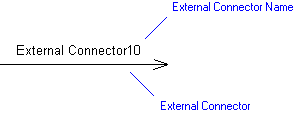External connector (dictionary item)

For automation interface information about an External Connector, see External connector (automation interface).
An External Connector is used to link an Actor with an Interface Device or Subsystem on a System Architecture Diagram.
You create an External Connector through the System Architecture Diagram. Modeler creates an External Connector when you add a Link between an Actor and an Interface Device or Subsystem.
When used on a System Architecture Diagram, an External Connector's notation is as follows:

The direction of an External Connection is represented as follows:

In the Modeler panes, a short-cut symbol  on the External Connector's icon indicates that the item is a stub.
on the External Connector's icon indicates that the item is a stub.
 on the External Connector's icon indicates that the item is a stub.
on the External Connector's icon indicates that the item is a stub.The access permissions you have to an External Connector are determined by the access permissions you have to the source item.
The following sections provide information about how an External Connector is used in the model. For more information about a property, item, model part or diagram, click it.
Properties
In addition to the standard properties, an External Connector has these properties:
• Direction (Flow Direction through the automation interface) — Specifies None, Start-End, End-Start or Bi-directional.
Owned by
An External Connector is owned jointly by the Actor and the Interface Device or Subsystem it links, that is, if either item is deleted the External Connector is deleted as well. The access permissions you have to an External Connector are determined by the access permissions you have to the source item. |
Owns
 Dependency — The Dependency is owned jointly by the External Connector and the other associated item. The access permissions you have to a Dependency are determined by the access permissions of the dependent item.
Dependency — The Dependency is owned jointly by the External Connector and the other associated item. The access permissions you have to a Dependency are determined by the access permissions of the dependent item.Defined in these parts of the model
Shown on these diagrams
Can be linked to these dictionary items
Like most other items in a Model, an External Connector can be linked to an Activity Partition, Comment, Frame Box, General Node, General Flow, General Flow Diagram Node, Constraint (applied), General Flow Diagram Flow or Swimlane. |
 Actor
Actor Interface Device
Interface Device Subsystem
Subsystem Comment
Comment System Architecture Model
System Architecture Model System Architecture Diagram
System Architecture Diagram Variant Diagram
Variant Diagram Stereotype
Stereotype